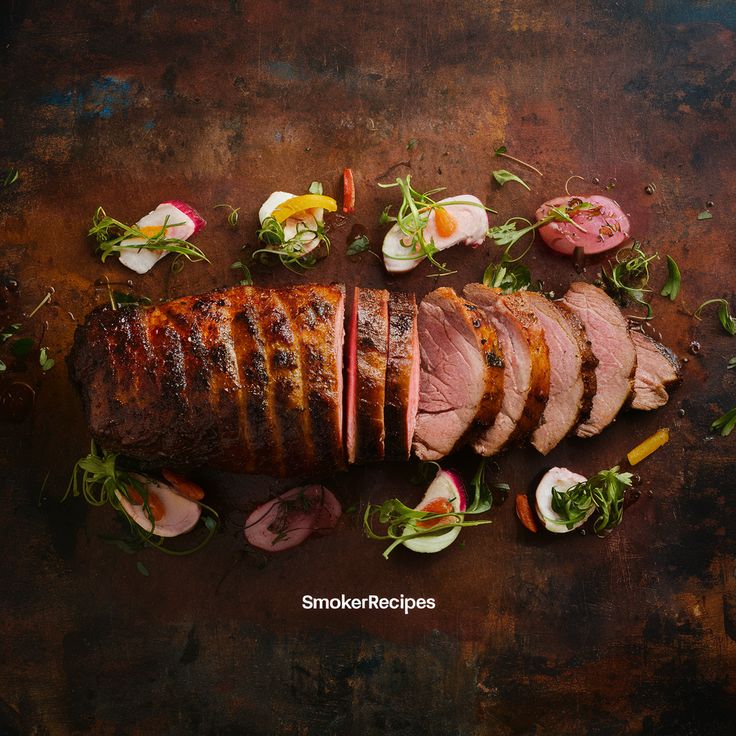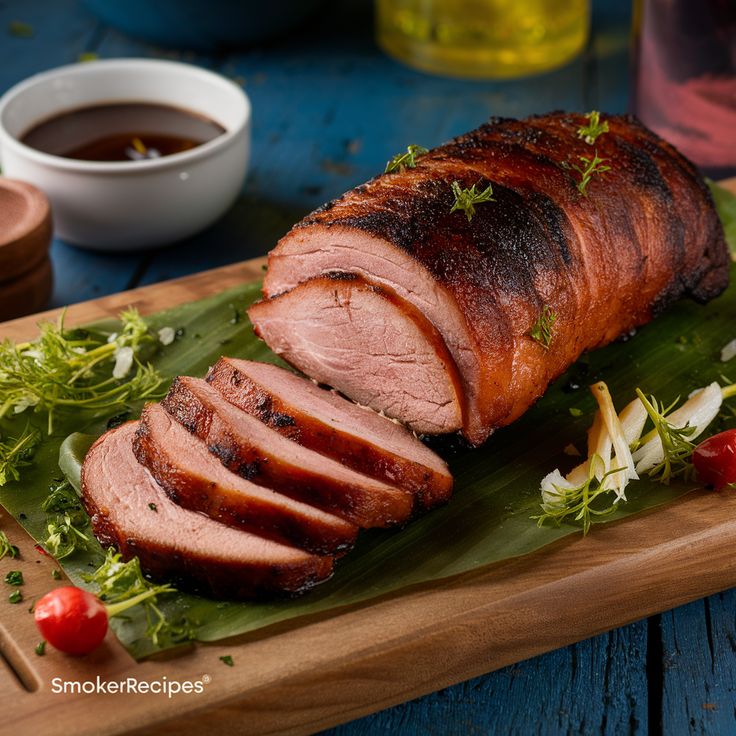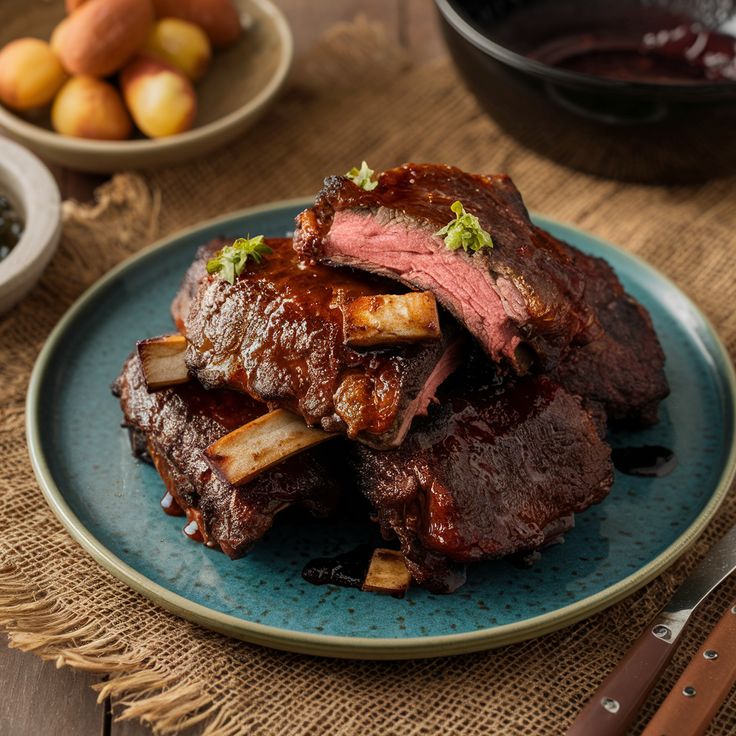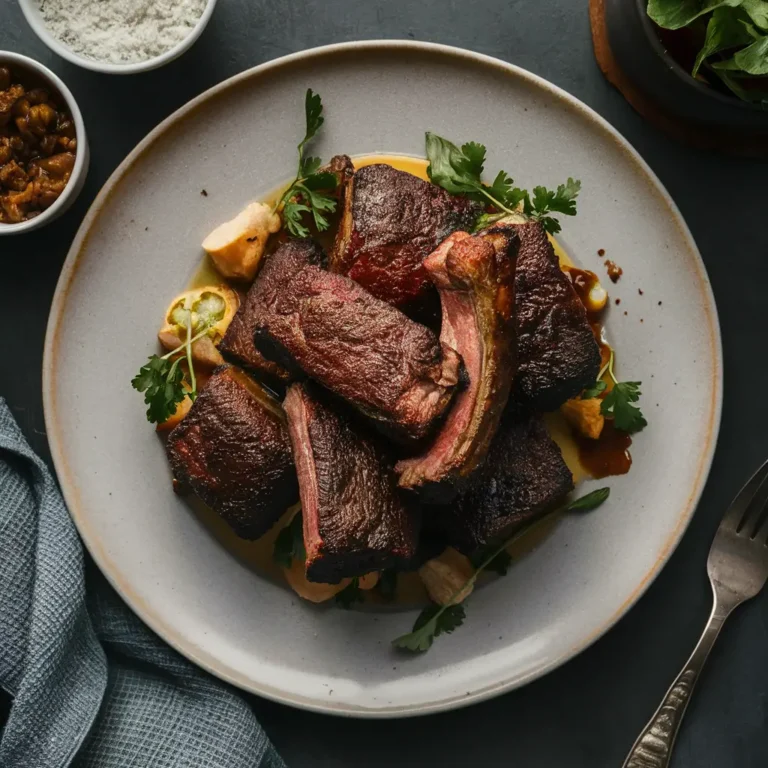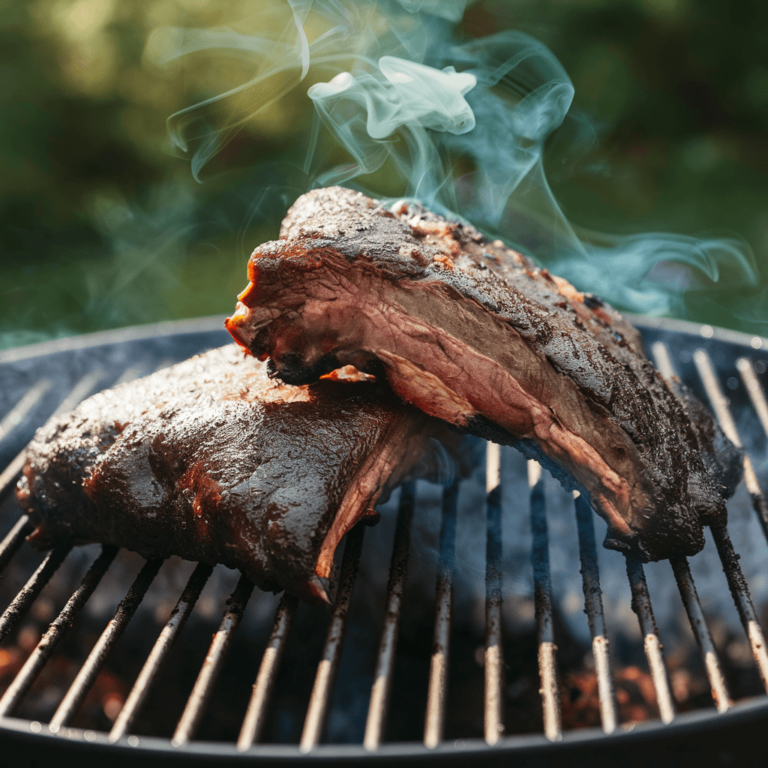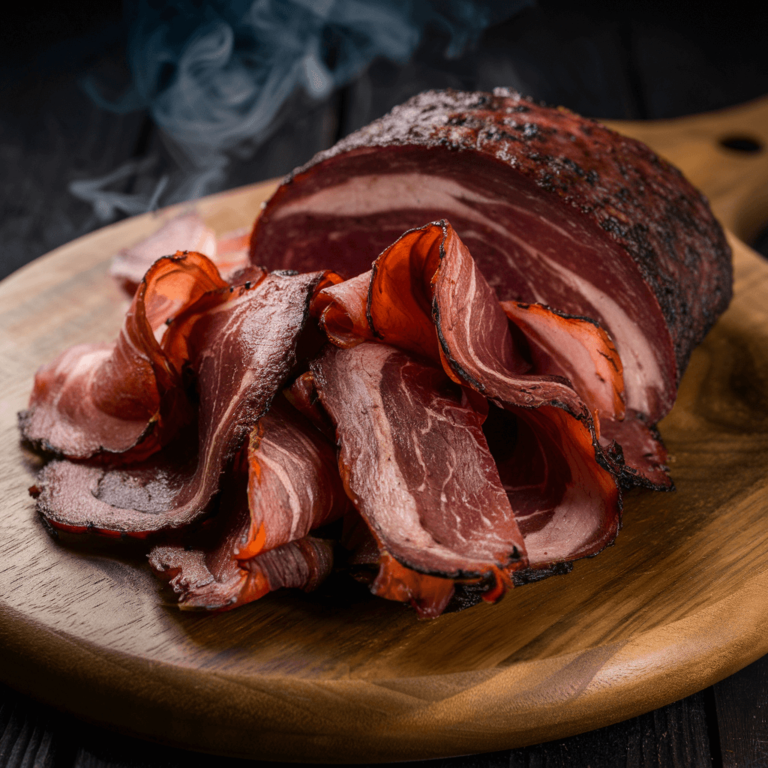Smoked pastrami: Discover the best 5 Secret Steps for Rich Taste
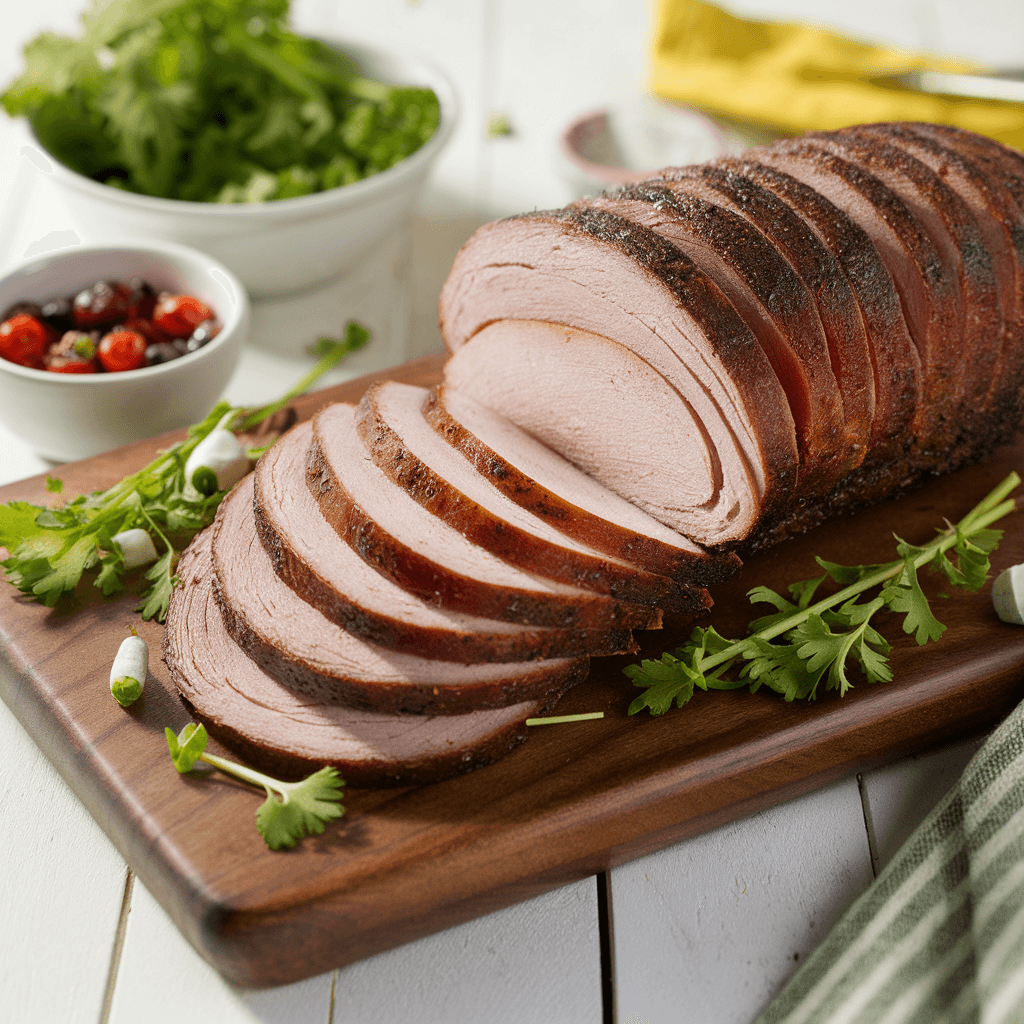
What is Smoked Pastrami?
Picture this: a bustling deli in New York City, the air thick with the aroma of spices and smoke. A customer leans over the counter, pointing to a stack of thinly sliced, ruby-red meat. “I’ll take a pastrami on rye,” they say, their voice tinged with anticipation. This is smoked pastrami—a culinary masterpiece that has captured hearts and taste buds for generations.
Smoked pastrami traces its roots back to Eastern Europe, where it began as a method of preserving meat. Jewish immigrants brought this tradition to America in the late 19th century, and it quickly became a staple in delis across the country. The process involves curing beef brisket with a blend of spices, smoking it to perfection, and steaming it for tenderness. The result? A melt-in-your-mouth delicacy with a smoky, peppery crust and a rich, savory interior.
Key ingredients include coriander, black pepper, garlic, and mustard seeds, which create the signature spice rub. Regional variations exist, with some recipes incorporating paprika or brown sugar for added depth. Whether served on rye bread with mustard or as the star of a hearty sandwich, smoked pastrami is a testament to the art of slow cooking and patience.
- Learn how to make tender and flavorful Turkey Pastrami with this step-by-step guide.
- Discover the perfect blend of spices with this authentic Pastrami Rub recipe.
Mastering Smoked Pastrami at Home
Creating smoked pastrami at home might seem daunting, but with the right tools and techniques, it’s entirely achievable. Start with a high-quality beef brisket, preferably the flat cut for even cooking. The curing process, which can take up to a week, is essential for developing flavor and tenderness. A simple brine of water, salt, sugar, and curing salt works wonders.
Essential Tools for the Job
To smoke pastrami like a pro, you’ll need a few key tools: a smoker (or a grill with a smoking attachment), a reliable meat thermometer, and a sharp knife for trimming the brisket. Wood chips, such as hickory or oak, add a robust smoky flavor that complements the spices.
Core Techniques for Success
After curing, rinse the brisket thoroughly and coat it generously with the spice rub. Smoke the meat at a low temperature (around 225°F) for several hours until it reaches an internal temperature of 165°F. For the final touch, steam the pastrami to achieve that signature tenderness. This step also helps to lock in moisture and flavor.
Pro Tips for Flavor and Efficiency
For a time-saving hack, consider using a pre-made spice rub or curing mix. To enhance flavor, let the brisket rest in the refrigerator overnight after applying the rub. This allows the spices to penetrate the meat more deeply. And don’t forget to slice the pastrami against the grain for maximum tenderness.
Smoked pastrami is more than just a dish—it’s a labor of love that connects us to history and tradition. Whether you’re a seasoned pitmaster or a curious home cook, mastering this recipe is a rewarding journey. Ready to dive in? Start your culinary adventure by exploring more recipes and tips from our blog.
Table of Contents
📜 Historical Information
Smoked pastrami traces its roots to Eastern Europe, particularly Romania, where it was originally created as a method to preserve meat. Jewish immigrants brought this delicacy to the United States in the late 19th century, where it evolved into the iconic dish we know today. Traditionally made from beef brisket, pastrami is cured, seasoned, and smoked to perfection, becoming a staple in delis and a symbol of cultural fusion.
🥕 What You’ll Need
Here’s everything you need to make smoked pastrami for 4 servings:
- 4 lbs beef brisket (preferably with a fat cap for flavor)
- 1/2 cup kosher salt (or sea salt for a cleaner taste)
- 1/4 cup brown sugar (or coconut sugar as a healthier alternative)
- 3 tbsp black peppercorns (coarsely ground for a robust flavor)
- 2 tbsp coriander seeds (toasted for enhanced aroma)
- 2 tbsp paprika (smoked paprika for a deeper flavor)
- 4 garlic cloves (minced for a pungent kick)
- 1 tbsp mustard seeds (optional for added texture)
- 1 gallon water (for the brine)
Health Benefits of Key Ingredients
- Beef Brisket: Rich in protein and essential nutrients like iron and zinc, which support muscle growth and immune function.
- Garlic: Known for its anti-inflammatory and heart-healthy properties, garlic adds both flavor and wellness benefits.
Nutrition Facts (Per Serving)
| Calories | Protein | Fat | Carbohydrates |
|---|---|---|---|
| 350 kcal | 28g | 22g | 5g |
👩🍳 Cooking Instructions
1. Prep Work
Start by preparing your brisket. Trim excess fat, leaving a thin layer for flavor. Combine water, kosher salt, and brown sugar in a large pot to create the brine. Submerge the brisket in the brine, cover, and refrigerate for 5-7 days. Rotate the brisket daily to ensure even curing.
2. Core Technique Walkthrough
After curing, rinse the brisket thoroughly and pat it dry. Mix black peppercorns, coriander seeds, paprika, garlic, and mustard seeds to create the rub. Generously coat the brisket with the spice mixture. Preheat your smoker to 225°F (107°C) and use hickory or oak wood chips for a classic smoky flavor. Smoke the brisket for 6-8 hours, maintaining a consistent temperature.
3. Doneness Indicators
The pastrami is ready when it reaches an internal temperature of 195°F (90°C). The meat should be tender and pull apart easily with a fork. The bark (outer layer) should be dark and crusty, while the inside remains juicy.
4. Pro Preservation Method
To store smoked pastrami, wrap it tightly in butcher paper or aluminum foil and refrigerate for up to a week. For longer storage, slice the pastrami, vacuum-seal it, and freeze for up to 3 months. Reheat gently in a steamer or oven to retain moisture.
🌍 Creative Variations
Dietary Needs
For a leaner option, use turkey breast instead of beef brisket. Adjust the brine and rub to suit your taste preferences.
Regional Flavors
Give your pastrami a Tex-Mex twist by adding chili powder and cumin to the rub. For a Mediterranean flair, incorporate oregano and lemon zest into the seasoning mix.
Seasonal Ingredients
In the fall, add a touch of maple syrup to the brine for a sweet, autumnal flavor. During summer, pair your pastrami with fresh, tangy coleslaw for a refreshing contrast.
Final Thoughts
Smoked pastrami is more than just a dish—it’s a celebration of history, culture, and culinary craftsmanship. Whether you stick to the traditional recipe or experiment with creative variations, this flavorful meat is sure to impress. Happy smoking!
Smoked pastrami: Discover the best 5 Secret Steps for Rich Taste
Cuisine: American4
servings1
hour7
hours40
minutes350
kcal8
hours40
minutesIngredients
- Brine
4 cups water
1/2 cup kosher salt
1/2 cup brown sugar
2 bay leaves
1 tablespoon black peppercorns
1 tablespoon coriander seeds
4 garlic cloves, smashed
- Meat
4-5 lb beef brisket (preferably the flat cut)
- Rub
2 tablespoons coarsely ground black pepper
2 tablespoons coarsely ground coriander seeds
1 tablespoon smoked paprika
1 tablespoon garlic powder
1 tablespoon onion powder
Directions
- Preparation
- Step 1: Brining
- In a large container, combine water, kosher salt, brown sugar, bay leaves, peppercorns, coriander seeds, and garlic.
- Submerge the brisket in the brine, cover, and refrigerate for 5-7 days to cure.
- After brining, remove the brisket, rinse it thoroughly under cold water, and pat dry with paper towels.
- Step 2: Applying the Rub
- In a bowl, mix together all the rub ingredients.
- Rub the spice mixture evenly over the entire brisket, ensuring full coverage.
- Wrap the brisket in plastic wrap and refrigerate for at least 24 hours to allow the flavors to meld.
- Step 3: Smoking
- Preheat your smoker to 225°F (107°C).
- Place the brisket in the smoker and smoke for 6-8 hours, or until the internal temperature reaches about 195°F (90°C) for maximum tenderness.
- Use wood such as hickory or oak to impart an authentic smoky flavor.
- Step 4: Finishing (Optional Steaming)
- For a traditional pastrami texture, transfer the smoked brisket to a steamer.
- Steam over boiling water for 1-2 hours until the meat is exceptionally tender.
- Alternatively, allow the brisket to rest for 30 minutes before slicing if you prefer not to steam.
- Step 5: Slicing and Serving
- Slice the pastrami thinly against the grain.
- Serve on rye bread with mustard, or enjoy as part of a deli-style platter.
- Pro Tips
- The longer the brining and curing process, the more flavorful and tender your pastrami will become.
- Let the meat rest after smoking for at least 30 minutes to ensure the juices redistribute.
- Store any leftovers in an airtight container in the refrigerator for up to 5 days, or freeze for longer storage.
Insider Techniques for Smoked Pastrami
Smoked pastrami is a culinary art that requires precision, patience, and a deep understanding of flavor and texture. Here are three rarely-shared professional methods to elevate your smoked pastrami game:
Texture Mastery: Achieving the Crispy-Tender Balance
The perfect smoked pastrami strikes a delicate balance between a crispy exterior and a tender, juicy interior. To achieve this:
- Use a two-stage cooking process: smoke the meat at a low temperature (225°F) for several hours to develop flavor, then finish it with a high-temperature sear to crisp the bark.
- Wrap the pastrami in butcher paper during the final hours of smoking to retain moisture while allowing the bark to set.
- Rest the meat for at least 30 minutes before slicing to let the juices redistribute, ensuring a tender bite.
Flavor Layering: Timing Your Herb and Spice Application
Flavor layering is key to creating a complex, mouthwatering pastrami. Follow these steps:
- Apply a dry rub of coriander, black pepper, garlic powder, and mustard seeds at least 24 hours before smoking to allow the spices to penetrate the meat.
- During smoking, periodically spritz the pastrami with a mixture of apple cider vinegar and water to enhance the bark and add a tangy note.
- Finish with a light glaze of honey or molasses during the last 30 minutes of smoking for a subtle sweetness that complements the savory spices.
Time-Saving Prep Hacks
Smoking pastrami can be time-consuming, but these hacks will streamline your process:
- Pre-cure the brisket in a brine solution for 5-7 days to reduce smoking time while intensifying flavor.
- Use a pellet smoker for consistent temperature control, allowing you to focus on other tasks.
- Slice and freeze portions of pastrami in vacuum-sealed bags for quick, ready-to-use meals.
Storage Instructions for Smoked Pastrami
Proper storage is essential to maintain the quality and flavor of your smoked pastrami. Here’s how to do it right:
Short-Term Storage (Up to 3 Days)
For short-term storage:
- Wrap the pastrami tightly in plastic wrap or aluminum foil to prevent air exposure.
- Store it in the coldest part of your refrigerator, ideally at 34-38°F.
- Place the wrapped pastrami in an airtight container to further protect it from odors and moisture loss.
Long-Term Storage (Up to 3 Months)
For long-term storage:
- Vacuum-seal the pastrami in portions to prevent freezer burn and maintain freshness.
- Label each package with the date to keep track of storage time.
- Store in a deep freezer at 0°F or below for optimal preservation.
Revival Techniques for Dried-Out Portions
If your pastrami has dried out, don’t despair. Try these revival methods:
- Steam the slices for 5-10 minutes to rehydrate and restore tenderness.
- Wrap the pastrami in a damp paper towel and microwave on low power for 30-second intervals until it regains moisture.
- Use dried-out pastrami in soups or stews, where it can absorb liquid and contribute rich flavor.

Plate Perfection: Serving Smoked Pastrami
Presentation and serving techniques can elevate your smoked pastrami from delicious to unforgettable. Here’s how to impress your guests:
Occasion-Based Presentation
Tailor your presentation to the occasion:
- For casual gatherings, serve thick slices on a wooden board with pickles, mustard, and rye bread for a DIY sandwich station.
- For gourmet dinners, plate thin slices fanned out on a white platter, garnished with microgreens and a drizzle of horseradish cream.
Garnish Pairings
Enhance your pastrami with complementary garnishes:
- Fresh dill or parsley adds a bright, herbaceous note.
- Edible flowers like nasturtiums or pansies provide a pop of color and subtle peppery flavor.
- Pickled vegetables, such as red onions or carrots, offer a tangy contrast.
Temperature Control During Service
Maintaining the right temperature is crucial:
- Serve pastrami warm (around 140°F) to highlight its juiciness and aroma.
- Use a warming tray or chafing dish to keep it at the ideal temperature during extended service.
- For cold pastrami dishes, chill the meat thoroughly and serve on a bed of ice to keep it fresh and firm.
Fix Common Issues: Troubleshooting Toolkit
Even the best chefs encounter challenges. Here’s how to fix common smoked pastrami problems:
Over-Seasoning Fixes
If your pastrami is too salty or spicy:
- Soak the meat in cold water for 1-2 hours to draw out excess salt.
- Balance the flavor by serving with unsalted sides like plain mashed potatoes or steamed vegetables.
- Dilute the seasoning by slicing the pastrami thinly and pairing it with mild accompaniments like cream cheese or avocado.
Texture Rescue Methods
If the texture is off:
- For tough pastrami, slice it against the grain and serve with a rich sauce like béarnaise or au jus to add moisture.
- For overly soft pastrami, chill it in the refrigerator for an hour before slicing to firm it up.
❓ Smoked Pastrami Recipe FAQs ❓
What’s the difference between smoked meat and pastrami?
Pastrami:
Made specifically from beef (typically the navel or brisket) and heavily seasoned with spices like coriander, black pepper, and garlic.
It is cured, smoked, and then steamed, which gives it a tender texture and a distinctive flavor.
Smoked Meat:
A broader category that includes any meat that has been cured and then smoked.
The preparation and seasoning can vary widely; not all smoked meats are steamed or seasoned with the traditional pastrami spice rub.
What is pastrami in the UK?
In the UK, it is generally still called pastrami, although it is less common than in the United States.
It is available in specialty delis and select supermarkets, retaining the same preparation and flavor profile as its American counterpart.
Ingredient Flexibility of Smoked Pastrami
Explore substitutions for:
Smoked pastrami recipes can be adapted to suit various dietary needs and ingredient availability. For vegan options, consider using seitan or jackfruit as a meat substitute. For gluten-free diets, ensure your spice blends and curing agents are gluten-free. If certain regional ingredients are unavailable, such as specific spices, you can substitute with similar flavors like smoked paprika or coriander. To adjust the flavor profile, experiment with different spice blends or brines to suit your taste preferences.
Troubleshooting Guide
Address common issues like:
If your smoked pastrami turns out too dry, it may have been overcooked or lacked sufficient fat. Try basting it during smoking or wrapping it in foil to retain moisture. For too moist pastrami, ensure proper drying after brining and monitor internal temperature during smoking. If the flavor is over-seasoned, reduce the amount of salt or spices in the brine or rub. Adjust cooking times based on the size of your cut and the smoker’s temperature to achieve the perfect texture.
Make-Ahead Strategies
Detail methods for:
Smoked pastrami can be partially prepped in advance. You can brine the meat up to a week ahead and store it in the refrigerator. For full recipe freezing, smoke the pastrami, let it cool, and wrap it tightly in foil or vacuum-seal it before freezing. It can be stored for up to 3 months. To reheat, thaw in the refrigerator overnight and warm it in the oven or steamer to retain moisture. Proper storage and reheating ensure the pastrami stays flavorful and tender.
Health-Conscious Options
Provide alternatives for:
For a lower-calorie version, trim excess fat from the meat before smoking and use a leaner cut like brisket flat. To adjust macronutrients, consider a low-carb approach by serving the pastrami with fresh salads or low-carb wraps. For high-protein options, pair it with protein-rich sides like beans or quinoa. For allergen-free variations, ensure all ingredients, including spices and brines, are free from common allergens like gluten or soy.
Taste Personalization
Suggest modifications for:
Adjust the spice level by reducing or increasing the amount of black pepper or chili flakes in the rub. To incorporate regional flavors, experiment with spices like cumin for a Middle Eastern twist or Sichuan peppercorns for an Asian-inspired version. For kid-friendly adaptations, reduce the spice level and serve the pastrami in sandwiches or wraps with mild condiments like mustard or mayo. Customizing the flavor ensures the dish appeals to everyone at the table.
Key Takeaways of Smoked Pastrami
Congratulations! You’ve just unlocked the secrets to making mouthwatering smoked pastrami at home. This recipe isn’t just about cooking—it’s about mastering a craft. Here’s what you’ve accomplished:
Essential Techniques Mastered
From brining your brisket to achieving the perfect smoke ring, you’ve learned the art of patience and precision. Smoking pastrami is a labor of love, and you’ve embraced every step, from trimming the meat to balancing the smoke and spice.
Special Ingredients Highlighted
You’ve discovered the magic of coriander, black pepper, and mustard seeds in creating that signature pastrami crust. The blend of spices, combined with the smoky depth from your smoker, transforms a simple cut of meat into a culinary masterpiece.
Cultural Significance Explored
Pastrami isn’t just a sandwich filling—it’s a story of tradition and heritage. By making it at home, you’ve connected with a rich history that spans delis in New York City to family kitchens around the world. It’s a dish that brings people together, and now you’re part of that legacy.
Your Culinary Journey Starts Here
Now that you’ve got the recipe, it’s time to make it your own. Here’s how you can take the next step:
Try the Recipe This Week
Don’t let this recipe sit on the shelf—fire up your smoker and give it a go! Whether it’s for a weekend feast or a weeknight treat, smoked pastrami is always a crowd-pleaser.
Share Your Creations Online
We’d love to see your smoked pastrami in action! Snap a photo, share it on Instagram, and tag @SmokerRecipes. Your masterpiece might just inspire someone else to start their smoking journey.
Tag @SmokerRecipes for Feedback
Got questions or proud of your results? Tag us for tips, feedback, or just to show off your skills. We’re here to cheer you on every step of the way.
Join Our Foodie Family
Smoking pastrami is just the beginning. Let’s keep the culinary adventures going together:
• Follow on Instagram: Get daily inspiration, behind-the-scenes tips, and mouthwatering recipes by following @Smokerrecipes.
• Explore Pinterest Boards: Dive into our curated boards for more dessert ideas, seasonal recipes, and creative plating tips.
• Join Our Facebook Group: Connect with fellow foodies, share your cooking triumphs, and get advice in our friendly Facebook community.
Expand Your Skills
Ready to take your cooking to the next level? Here are some ideas to keep the momentum going:
Related Recipes to Try
If you loved this smoked pastrami, why not try your hand at smoked brisket, pulled pork, or even smoked salmon? Each recipe builds on the skills you’ve already mastered.
Seasonal Variations to Explore
Switch things up with seasonal twists. Add a touch of maple syrup in the fall or experiment with citrusy rubs in the summer. Pastrami is versatile—make it your own!
Cooking Challenges to Attempt
Feeling adventurous? Try a 12-hour smoke or experiment with different wood chips for unique flavors. Every challenge is a chance to grow as a cook.
Remember, cooking is about more than just food—it’s about creating memories, sharing stories, and bringing people together. So, grab your apron, fire up the smoker, and let’s keep the good times rolling. Happy smoking!


